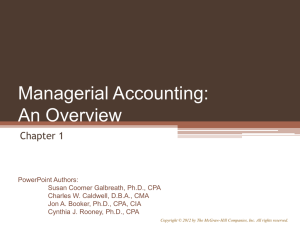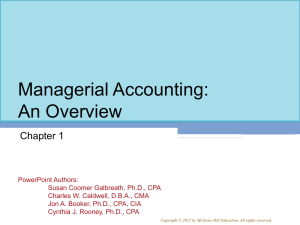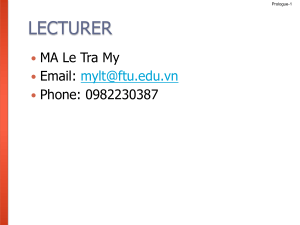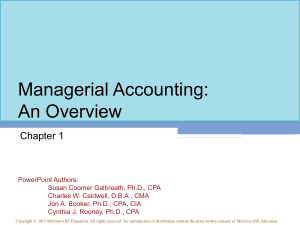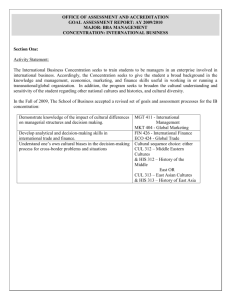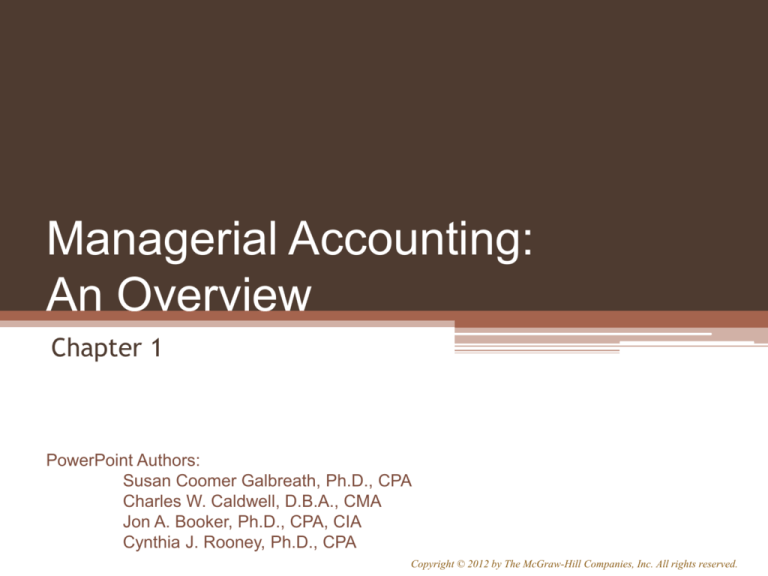
Managerial Accounting:
An Overview
Chapter 1
PowerPoint Authors:
Susan Coomer Galbreath, Ph.D., CPA
Charles W. Caldwell, D.B.A., CMA
Jon A. Booker, Ph.D., CPA, CIA
Cynthia J. Rooney, Ph.D., CPA
Copyright © 2012 by The McGraw-Hill Companies, Inc. All rights reserved.
1-2
Financial and Managerial
Accounting: Seven Key Differences
Financial Accounting
Managerial Accounting
External persons who
make financial decisions
Managers who plan for
and control an organization
Historical perspective
Future emphasis
3. Verifiability
versus relevance
Emphasis on
objectivity and verifiability
Emphasis on
relevance
4. Precision versus
timeliness
Emphasis on
precision
Emphasis on
timeliness
Primary focus is on
companywide reports
Focus on
segment reports
Must follow GAAP / IFRS
and prescribed formats
Not bound by GAAP / IFRS
or any prescribed format
Mandatory for
external reports
Not
Mandatory
1. Users
2. Time focus
5. Subject
6. Rules
7. Requirement
1-3
Work of Management
Planning
Controlling
Decision
Making
1-4
Planning
Establish Goals.
Specify How Goals
Will Be Achieved.
Develop Budgets.
1-5
Controlling
The control function gathers feedback to
ensure that plans are being followed.
Feedback in the form of performance reports
that compare actual results with the budget
are an essential part of the control function.
1-6
Decision Making
Decision making involves
making a selection among
competing alternatives.
What should
we be selling?
Who should
we be serving?
How should
we execute?
1-7
Managerial Accounting Activities:
Marketing Majors
Planning
How much should we budget for
TV, print, and internet advertising?
How many salespeople should we
plan to hire to serve a new
territory?
1-8
Managerial Accounting Activities:
Marketing Majors
Controlling
Is the budgeted price cut increasing
unit sales as expected?
Are we accumulating too much
inventory during the holiday
shopping season?
1-9
Managerial Accounting Activities:
Marketing Majors
Decision
Making
Should we sell our services as
one bundle or sell them
separately?
Should we sell directly to
customers or use a distributor?
1-10
Managerial Accounting Activities:
Operations Management Majors
Planning
How many units should we plan to
produce next period?
How much should we budget for
next period’s utility expense?
1-11
Managerial Accounting Activities:
Operations Management Majors
Controlling
Did we spend more or less than
expected for the units we actually
produced?
Are we achieving our goal of
reducing the number of defective
units produced?
1-12
Managerial Accounting Activities:
Operations Management Majors
Decision
Making
Should we buy a new piece of
equipment or upgrade our existing
machine?
Should we redesign our
manufacturing process to lower
inventory levels?
1-13
Managerial Accounting Activities:
Human Resource Management Majors
Planning
How much should we plan to
spend for occupational safety
training?
How much should we plan to
spend on employee recruitment
advertising?
1-14
Managerial Accounting Activities:
Human Resource Management Majors
Controlling
Is our employee retention rate
exceeding our goals?
Are we meeting our goal of
completing timely performance
appraisals?
1-15
Managerial Accounting Activities:
Human Resource Management Majors
Decision
Making
Should we hire an on-site medical
staff to lower our healthcare
costs?
Should we hire temporary workers
or full-time employees?
1-16
Accounting Majors
Many accounting graduates
begin working for public
accounting firms. However,
most leave at some point to
work in other organizations.
80%
The IMA estimates that 80%
of professional accountants in
the U.S. work in non-public
accounting environments.
1-17
Certified Management Accountant
A management accountant
who has the necessary qualifications
and who passes a rigorous professional
exam earns the right to be known as a
Certified Management Accountant
(CMA).
1-18
CMA Exam
Part 1 Financial Planning, Performance and Control
Planning, budgeting, and forecasting
Performance management
Cost management
Internal controls
Professional ethics
Part 2 Financial Decision Making
Financial statement analysis
Corporate finance
Decision analysis and risk management
Investment decisions
Professional ethics
Information about becoming a CMA and the CMA program can be accessed
on the IMA’s website at www.imanet.org or by calling 1-800-638-4427.
1-19
Strategic Management Skills
A strategy
is a “game plan”
that enables a company
to attract customers
by distinguishing itself
from competitors.
The focal point of a
company’s strategy should
be its target customers.
1-20
Customer Value Propositions
Customer
Intimacy
Strategy
Understand and respond to
individual customer needs.
Operational
Excellence
Strategy
Deliver products and services
faster, more conveniently,
and at lower prices.
Product
Leadership
Strategy
Offer higher quality products.
1-21
Enterprise Risk Management
A process used
by a company to
proactively identify
and manage risk.
Should I try to avoid the
risk, accept the risk, or
reduce the risk?
Once a company identifies its risks, perhaps the
most common risk management tactic is to reduce
risks by implementing specific controls.
1-22
Enterprise Risk Management
Examples of Business Risks
● Products harming customers
●
● Losing market share due to the
unforeseen actions of competitors
●
● Poor weather conditions shutting
down operations
●
● Website malfunction
●
● A supplier strike halting the flow
of raw materials
●
● Financial statements unfairly
reporting the value of inventory
●
● An employee accessing
unauthorized information
●
Examples of Controls to
Reduce Business Risks
Develop a formal and rigorous
new product testing program
Develop an approach for legally
gathering information about
competitors' plans and practices
Develop contingency plans for
overcoming weather-related
disruptions
Thoroughly test the website
before going "live" on the Internet
Establish a relationship with two
companies capable of providing
raw materials
Count the physical inventory on
hand to make sure that it agrees
with the accounting records
Create password-protected barriers
that prohibit employees from
obtaining information not needed
to do their jobs
1-23
Process Management
A business
process is a series of
steps that are followed in order to
carry out some task in
a business.
R&D
Product
Design
Customer
Manufacturing Marketing Distribution Service
Business functions making up the value chain
1-24
Lean Production
Customer places
an order
Create Production
Order
Generate component
requirements
Goods delivered
when needed
Production begins
as parts arrive
Components
are ordered
Lean Production is often called Just-In-Time (JIT) production.
1-25
Lean Production
Traditional Manufacturing
Produce goods in
anticipation of Sales
Store
Inventory
Make Sales from
Finished Goods
Inventory
1-26
Lean Production
Because lean thinking only allows production in
response to customer orders, the number of units
produced tends to equal the number of units sold.
The lean approach also results in fewer defects,
less wasted effort, and quicker customer response
times than traditional production methods.
1-27
Theory of Constraints
A constraint (also called a bottleneck) is anything that
prevents you from getting more of what you want.
The Theory of Constraints (TOC) is based on the
observation that effectively managing the constraint is the
key to success.
The constraint in a system is determined
by the step that has the smallest capacity.
1-28
Theory of Constraints
2. Allow the
weakest link to
set the tempo.
Only actions
that
strengthen the
weakest link in
the “chain”
improve the
process.
3. Focus on
improving
the weakest
link.
1. Identify the
weakest link.
4. Recognize that
the weakest link
is stronger.
1-29
Measurement Skills
A good manager
complements an
understanding of
strategy, risks, and
business processes with
data-driven analysis.
The key to effective analysis is to understand that
the question you are addressing defines what you
measure and how you analyze the data.
1-30
Measurement Skills
What net income should my company report
to its stockholders?
Measure and report historical data that
complies with applicable rules.
How will my company serve its customers?
Measure and analyze mostly non-financial,
process-oriented data.
Will my company need to borrow money?
Measure and analyze estimated future cash
flows.
1-31
Measurement Skills
The primary purpose
of this course is to
teach measurement
skills that managers
use to support
planning, controlling,
and decision making
activities.
Planning
Controlling
Decision
Making
1-32
Leadership Skills
Six Skills of an Effective Leader
1. Technical competence
2. High integrity
3. Understand how to implement organizational
change
4. Strong communication skills
5. Capable of motivating and mentoring other
people
6. Effectively manage team-based decision
processes
1-33
Code of Conduct for Management
Accountants
The Institute of Management Accountant’s (IMA)
Statement of Ethical Professional Practice
consists of two parts that offer guidelines for:
Ethical behavior.
Resolution for an ethical conflict.
1-34
IMA Guidelines for Ethical Behavior
Recognize and
communicate professional
limitations that preclude
responsible judgment.
Maintain
professional
competence.
Competence
Provide accurate, clear,
concise, and timely decision
support information.
Follow applicable
laws, regulations
and standards.
1-35
IMA Guidelines for Ethical Behavior
Do not disclose confidential
information unless legally
obligated to do so.
Do not use
confidential
information for
unethical or illegal
advantage.
Confidentiality
Ensure that subordinates do
not disclose confidential
information.
1-36
IMA Guidelines for Ethical Behavior
Mitigate conflicts of
interest and advise others
of potential conflicts.
Refrain from
conduct that
would prejudice
carrying out
duties ethically.
Integrity
Abstain from activities that
might discredit the
profession.
1-37
IMA Guidelines for Ethical Behavior
Communicate information
fairly and objectively.
Credibility
Disclose all relevant
information that could
influence a user’s
understanding of reports
and recommendations.
Disclose delays or
deficiencies in information
timeliness, processing, or
internal controls.
1-38
IMA Guidelines for Resolution of an
Ethical Conflict
Follow employer’s established policies.
For an unresolved ethical conflict:
▫ Discuss the conflict with immediate supervisor or next
highest uninvolved managerial level.
▫ If immediate supervisor is the CEO, consider the
board of directors or the audit committee.
▫ Contact with levels above the immediate supervisor
should only be initiated with the supervisor’s
knowledge, assuming the supervisor is not involved.
1-39
IMA Guidelines for Resolution of an
Ethical Conflict
Follow employer’s established policies.
For an unresolved ethical conflict:
▫ Except where legally prescribed, maintain
confidentiality.
▫ Clarify issues in a confidential discussion with an
objective advisor.
▫ Consult an attorney as to legal obligations.
1-40
Why Have Ethical Standards?
Ethical standards in business are essential for a
smooth functioning economy.
Without ethical standards in business, the
economy, and all of us who depend on it for
jobs, goods, and services, would suffer.
Abandoning ethical standards in business would
lead to a lower quality of life with less
desirable goods and services at higher prices.
1-41
Corporate Social Responsibility
Corporate social responsibility (CSR) is a concept
whereby organizations consider the needs
of all stakeholders when making decisions.
Customers
Employees
Suppliers
Communities
Stockholders
CSR extends beyond legal compliance
to include voluntary actions that satisfy
stakeholder expectations.
Environmental
& Human Rights
Advocates
1-42
Corporate Social Responsibility
Examples of Corporate Social Responsibility
Companies should provide customers with:
Companies and their suppliers should provide
● Safe, high quality products that are fairly
employees with:
priced
● Safe and humane working conditions
● Competent, courteous, and rapid delivery
● Non-discriminatory treatment and the
of products and services
right to organize and file grievances
● Full disclosure of product-related risks
● Fair compensation
● Easy to use information systems for
● Opportunities for training, promotion,
shopping and tracking orders
and personal development
Companies should provide suppliers with:
Companies should provide communities with:
● Fair contract terms and prompt payments
● Payment of fair taxes
● Reasonable time to prepare orders
● Honest information about plans such as
● Hassle-free acceptance of timely and
plant closings
complete deliveries
● Resources that support charities, schools,
● Cooperative rather than unilateral
and civic activities
actions
● Reasonable access to media sources
Companies should provide stockholders with: Companies should provide environmental
● Competent management
and human rights advocates with:
● Easy access to complete and accurate
● Greenhouse gas emissions data
financial information
● Recycling and resource conservation data
● Full disclosure of enterprise risks
● Child labor transparency
● Honest answers to knowledgeable
● Full disclosure of suppliers located in
questions
developing countries

